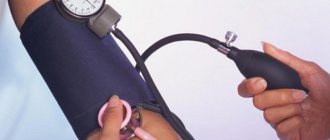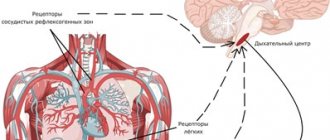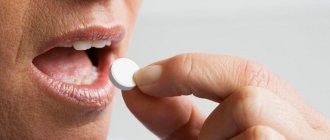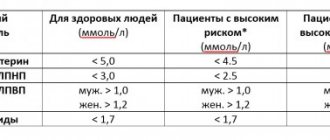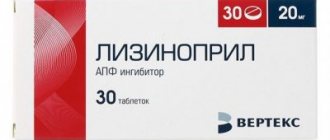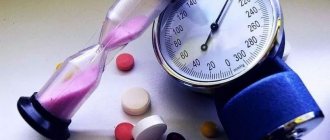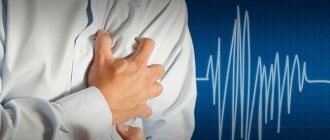The concept of “high blood pressure” covers a range of diseases - from primary hypertension (when the cause of the increase is not clear) to secondary conditions (in which the increase in blood pressure is caused, for example, by kidney pathology or a brain tumor).
Most hypertensive patients require drug therapy throughout their lives to prevent dangerous surges in blood pressure and the development of life-threatening complications. Depending on the type of hypertension, you need not one drug, but from two to six.
Modern medications used in cardiology include sartans, which are prescribed for arterial hypertension.
What it is
Sartans are drugs that block angiotensin II receptors (ARB II). Otherwise, the drugs also have this name: ARAs (or angiotensin receptor antagonists).
The “renin-angiotensin-aldosterone system” (RAAS) plays an equal role with the sympathoadrenal system in the formation of pathology of the heart and blood vessels (in particular, hypertension). Parts of the RAAS are scattered throughout the human body.
The same can be said about their receptors. For this reason, disturbances in the RAAS affect all life activities.
The products of activation of the system are the hormones angiotensin II and aldosterone. The first of these has a multifaceted effect on the body, namely: Angiotensin II has a strong pressor effect on blood vessels.
The result of exposure is a rapid and sharp rise in blood pressure. Life-threatening heart rhythm disorders may develop, as well as disruptions in the functioning of the heart muscle.
So these medications can help with insufficiently efficient functioning of the heart muscle (chronic form of heart failure), thickening (hypertrophy) of the walls of the heart, as well as metabolic disorders and abnormalities in the kidneys (in the presence of a pronounced increased loss of proteins from the body - albumin or the protein fraction in general ).
Sartans began to be synthesized in the 90s of the twentieth century and are still the newest drugs affecting the RAAS. Practical experience in their use is not so extensive; There is little fundamental research on their effectiveness.
Today, the range of sartans is mainly represented by the first generation, which has an effect only in the form of blockade of AT receptors. The latest (second) generation sartan, the advantage of which is multiple (pleiotropic) effects, is Telmisartan.
Blockade of AT receptors by sartans: what explains this effect, how long do sartans have this effect?
Impact principle
During the process of reducing pressure in the kidneys, oxygen deficiency occurs, resulting in the production of renin. It is with its help that angiotensin I appears, which is converted into angiotensin II. This substance is considered to be an active component that affects blood pressure, increasing it. Therefore, taking sartans if a patient has arterial hypertension helps to influence the receptors, which prevents hypertension.
Mechanism of action
Angiotensin II is capable of causing a jump in blood pressure only if it connects with its receptors, and it is necessary that the “landing sites” of this hormone remain free.
Ara drugs (ARA - angiotensin receptor antagonists) densely occupy the “landing sites” of AT II. Thus, its influence ceases. As a result, blood pressure is kept at a normal level.
This is important for patients suffering from hypertension; her drug treatment, including ARBs, is most effective.
The principle of the therapeutic effect of these drugs is explained by the suppression of the effects of AT II on the heart and blood vessels.
This hormone has a pronounced pressor effect, increases resistance in blood vessels located on the periphery, which leads to a rapid rise in blood pressure. Angiotensin II also has many other pathological effects.
Being antagonists of the receptors of this hormone, sartan preparations not only maintain normal blood pressure, but also control other pathologies.
Sartans can help with a certain range of diseases, including:
- Arterial hypertension (AH), especially accompanied by hypertrophy of the muscular wall of the left ventricle of the heart. Blood pressure decreases gently and smoothly, the maximum effect is achieved approximately in the third week of the treatment course.
- Chronic failure of the heart muscle. It is known that any pathology of the heart and vascular system (this also includes malfunctions in the functioning of regulatory centers) over time turns into a condition when the myocardium ceases to adequately cope with the load. From this moment on, its wear and tear is noted. Timely therapy with sartans in this case interrupts pathological connections and practically stops the wear and tear of the heart muscle.
- Kidney pathology (nephropathy). Sartans are prescribed to patients with secondary renal hypertension or nephropathy that has developed against the background of existing hypertension.
- Pathology of the heart and blood vessels against the background of insulin-dependent diabetes mellitus. The effect of sartans reduces tissue insulin resistance; therefore, it increases glucose utilization. This ensures that glucose concentrations are kept within normal limits.
- Diseases of the heart and vascular system due to lipid metabolism disorders. Sartans reduce high cholesterol levels in the blood serum, and also increase the level of “good” cholesterol (in high-density lipoproteins) and reduce “bad” cholesterol (in low- and very low-density lipoproteins).
The best sartans of the latest generation for blood pressure and arterial hypertension
New generation antihypertensive drugs include sartana drugs.
These are highly effective medications for lowering blood pressure, which are prescribed by the attending physician according to indications. They cause a minimum of adverse reactions and are well tolerated by patients if the prescribed treatment regimen is strictly followed. This is a young pharmacological group of drugs that has become an alternative to long-known angiotensin-converting enzyme inhibitors.
Before taking it, you need to read the instructions for use, understand the principle of action, analyze which drugs they are compatible with and which they cannot be taken together with.
Pharmacological effects
The renin-angiotensin system is responsible for blood flow and blood pressure. The functions of this system are to regulate vascular tone, the interaction of the liver, kidneys, adrenal glands, and the volume of fluid released. The enzyme angiotensin 2 constricts blood vessels, which increases blood pressure.
The group of sartans protects cells from the action of angiotensin 2. The drugs block the production of the enzyme, thereby protecting the walls of blood vessels. The vessels remain dilated, and the pressure does not rise.
Sartans not only have antihypertensive properties, but are also effectively used to treat renal disorders and abnormalities of the heart.
Sartans are one of the groups of drugs for the treatment of hypertension
The therapeutic effects of sartan drugs are reflected in the table.
ActionResult
| Cardioprotective, vasoprotective | the load on the myocardium is reduced; the rate of increase in the mass of the left ventricular myocardium slows down; the risk of developing atrial fibrillation is reduced; heart function is normalized in case of insufficiency |
| Neuroprotective | the risk of cerebrovascular accident is reduced; the risk of cognitive impairment in hypertensive patients is reduced |
| Renoprotective | tissue swelling decreases; potassium content increases; the risk of protein appearing in urine is reduced; the degree of development of kidney failure is reduced |
| Metabolic | sensitivity to insulin increases; blood sugar concentration decreases; the risk of developing atherosclerotic lesions is reduced; the likelihood of diabetes in hypertensive patients decreases; The level of triglycerides, cholesterol, low-density lipoproteins decreases; the level of high-density lipoproteins increases. |
Scheme describing the mechanism of action of sartans
Classification of sartans
Pressure sartans are divided into 4 groups according to chemistry. composition.
NameDrugs
| Biphenyl tetrazole derivatives | Irbesartan, Losartan, Candesartan |
| Non-biphenyl tetrazole derivatives | Telmisartan |
| Non-biphenyl non-tetrazoles | Eposartan |
| Non-heterocyclic compounds | Valsartan |
List of latest generation drugs
There are two generations of sartans for the treatment of hypertension: the first and the last.
First generation sartana tablets for blood pressure are Valsartan, Candesartan, Losartan, Olmesartan, Eprosartan, Irbesartan. They block the activity of the enzyme angiotensin 2.
The latest generation sartans reduce the production of angiotensin 2 and receptors activated by peroxisome proliferators-type receptors. They are responsible for:
- cellular differentiation;
- lipid and carbohydrate metabolism;
- insulin sensitivity;
- beta oxidation.
The only representative of the latest generation sold in Russia is Telmisartan. The drug effectively lowers blood pressure and has other pharmacological advantages:
- reduces the likelihood of developing atherosclerotic vascular lesions;
- lowers the content of triglycerides and glucose;
- restores hormonal activity of the pancreas;
- normalizes lipid metabolism in diabetics;
- stops inflammatory processes;
- eliminates adverse reactions from taking thiazide diuretics.
Telmisartan is one of the latest generation blood pressure medications
It is impossible to identify the best sartans based on their effect on pressure indicators. They all effectively lower blood pressure levels with a difference of 2 points.
The most popular sartana medications for hypertension are presented in the table.
Main active ingredientName of the drug
| Valsartan | Walz; Valsafors; Valsacor; Diovan; Nortivan;Tareg |
| Losartan | Blocktran; Vasotens; Zisakar; Carzartan; Lozap; Lorista;Renicard |
| Irbesartan | Aprovel; Ibertan;Firmasta |
| Candesartan | Angiakand; Atakand; Hyposart; Candecor; Xarthen;Ordiss |
| Olmesartan | Cardosal |
Popular representatives of sartans
Indications for use
Angiotensin 2 receptor blockers (ARBs) are prescribed to treat hypertension. In combination with other medications, ARBs are prescribed for the treatment of:
- chronic heart failure;
- lesions of the glomerular apparatus and renal parenchyma;
- microalbuminuria;
- left ventricular hypertrophy;
- diabetes;
- insulin resistance syndrome;
- atherosclerotic vascular lesions;
- atrial fibrillation;
- heart attack (using Valsartan).
Arterial hypertension and hypertension
To quickly lower blood pressure, doctors often prescribe angiotensin 2 receptor inhibitors. Sartans for arterial hypertension are especially effective if the patient has concomitant diagnoses:
- increased mass of the left ventricular myocardium;
- chronic heart failure;
- albuminuria;
- diabetes;
- renal failure;
- post-infarction cardiosclerosis.
For hypertension, sartans are prescribed instead of angiotensin-converting enzyme inhibitors if a severe cough occurs.
Blood pressure medications sartans are taken alone or in combination with other antihypertensive drugs. The effectiveness of monotherapy is 10-15% lower than complex therapy. Drugs with a cumulative effect show a pronounced effect in the treatment of hypertension a month after the start of the course.
Sartans are only one group of drugs that should be taken by hypertensive patients every day
Myocardial infarction
After a heart attack, the only drug from the group of angiotensin blockers that can be taken is Valsartan.
The drug reduces the likelihood of death from a heart attack by 25%.
The doctor prescribes Valsartan after myocardial infarction on days 3-10, when the risk of a sharp decrease in blood pressure disappears. The drug is effective for recurrent heart attacks to reduce the likelihood of complications.
Advantages of the sartan group
The main benefits of taking angiotensin 2 receptor antagonists:
- almost complete absence of contraindications;
- It is enough to take a long-acting drug once a day to lower blood pressure for a day;
- the likelihood of developing adverse reactions is minimal;
- drugs are prescribed for diabetes, in old age, and for impaired renal function;
- do not cause cough;
- increase the life expectancy of patients with disorders of the heart and blood vessels by several years;
- reduce the likelihood of developing cerebrovascular accidents;
- do not provoke the development of lung cancer.
Possible adverse reactions
Sartans are considered to be the safest blood pressure medications. The likelihood of developing side effects of sartans is so small that it is not included in a separate list. In rare cases, blood pressure sartans without side effects can cause dizziness due to a decrease in blood counts. Doctors advise taking pills at night to avoid any discomfort.
A side effect of taking sartans may be dizziness.
Contraindications
New sartans should not be prescribed for:
- increased susceptibility to the components of the drug;
- gestation;
- natural breastfeeding.
Doctors advise women of childbearing age to think about reliable methods of contraception to prevent pregnancy. If pregnancy occurs, you must stop taking the pills.
The safest medications are prescribed with extreme caution in the following cases:
- childhood;
- decreased circulating blood volume;
- bilateral renal artery stenosis;
- kidney failure;
- liver dysfunction, cirrhosis;
- blockage of the bile ducts;
- when taking potassium-sparing drugs.
Drug compatibility
Sartans interact well with other types of drugs without causing negative reactions. Sartans can be taken with any means for the treatment of heart and vascular diseases, diabetes. The drugs significantly reduce blood pressure, so it is necessary to control the dosage during complex therapy with other antihypertensive drugs.
Particular caution should be taken when taking tablets in combination with:
- NSAIDs: Ibuprofen, Nimesulide;
- potassium-sparing diuretics;
- heparin;
- potassium-containing drugs.
Do sartans cause cancer?
After a major study in 2010, which showed a direct correlation between the development of cancer and the use of angiotensin blockers, people became concerned.
Therefore, scientists conducted additional studies to identify the pattern of taking sartans with the development of malignant neoplasms.
Studies have shown that sartans do not increase the likelihood of developing cancer cells, but rather reduce the risk of colorectal cancer.
Even if some antihypertensive drugs can lead to the development of cancer, then this probability is low. It is not comparable to the high benefits of drugs for the treatment of hypertension.
Sartans and the risk of myocardial infarction
There are a number of studies that suggest a relationship between taking angiotensin blockers and the development of a heart attack. Detailed modern studies have shown that there is no such possibility; treatment with sartans does not provoke the development of myocardial infarction.
Valsartan is recommended to be taken to stop a recurrent heart attack.
Sartans protect the heart from heart attack
Sartans and ACE inhibitors - which is better?
Sartans are similar in their principle of action to angiotensin-converting enzyme inhibitors (ACE inhibitors). The action of the drugs is aimed at blocking the production of the enzyme angiotensin 2.
ARBs are more sensitive to angiotensin enzymes than ACEIs. They are more effective for hypertension and help with other disorders of the heart and blood vessels. Sartans reduce blood pressure, improve blood circulation, and reduce the load on the heart muscle.
Taking ACE inhibitors provokes the development of a severe cough in some patients. Sartans have virtually no contraindications or side effects when taken.
Angiotensin-converting enzyme inhibitors are still more commonly used to treat hypertension than sartans, as they have been well studied.
Doctors know the principle of their action, contraindications and other pharmacological properties. The pharmacokinetics and pharmacodynamics of sartans are still being studied, so doctors prescribe them only for complex forms of hypertension.
It has already been proven that the effectiveness of sartans in complex and monotherapy is higher.
Source: https://Gipertonicum.ru/preparaty/sartany
Classification of sartans
Several types of ARB classification have been developed:
- by chemical structure;
- focusing on the characteristics of pharmacokinetics;
- according to the mechanism of connection with receptors.
The classification of medicines (such as sartans) according to the structure of the substance is as follows. There are 4 groups of drugs:
- tetrazole heterocycles related to biphenyl aromatic compounds (“Losartan”, “Irbesartan”, “Candesartan”);
- tetrazole heterocycles of non-biphenyl compounds (“Telmisartan”);
- non-tetrazole heterocycles (non-biphenyl group like "Eprosartan");
- non-heterocycles (“Valsartan”).
Among the sartans there are:
- prodrugs (precursors of a drug; do not have independent activity);
- active dosage forms.
The first group includes, for example, Candesartan cilexetil. This remedy, when taken orally and undergoing metabolic transformations in the liver, becomes active and capable of exerting a therapeutic effect.
ARBs vary in their ability to form active metabolites. Thus, one of the representatives of the sartans “Losartan”, when taken orally, is quickly absorbed in the gastrointestinal tract and, when passing through the liver, attaches a carboxyl group, forming an active metabolite of the drug “Losartan” (its exact name is EXP-3174) 40 times more active, then It has a more significant effect than the drug itself. Such a metabolite is also formed in Tazosartan.
Based on the nature of their effects on AT receptors, sartans (and their metabolites) are classified into 2 categories: those with a competitive mechanism of action and non-competitive (classification based on the reversibility of the “drug-receptor” connection).
The first category includes “Eprosartan” and “Losartan”, which form a temporary, reversible connection with receptor sites (under certain conditions they leave the binding sites and release the receptor).
Non-competitive (that is, forming an irreversible, strong bond) are Valsartan, Candesartan, Irbesartan, Telmisartan, as well as the active metabolite of losartan.
Peculiarities
Self-treatment with sartans is prohibited; the treatment regimen must be selected by the doctor individually for each patient. Before prescribing medications, special diagnostics are carried out and the characteristics of the patient’s condition are studied.
Important! The drugs must be taken every day, without interruption.
Doctors often prescribe a combination of sartans and diuretics. The most well-known drugs for the treatment of hypertension are:
- "Micardis", it contains hydrochlorothiazide, as well as telmisartan;
Mikardis - "Teveten" has hydrochlorothiazide and eprosartan as its base substances;
Teveten - "Atacand Plus" is distinguished by the presence of candesartan, hydrochlorothiazide.
These substances are also responsible for protecting internal organs; they are safe as they have no side effects.
"Renicard"
Renicard is a brand name for an ARB medication that contains losartan potassium as the active ingredient. Produced in 25 mg film-coated tablets.
Prescribed to patients suffering from high blood pressure and left ventricular hypertrophy, in order to reduce cardiovascular mortality, with type 2 diabetes, accompanied by the presence of protein in the urine, with chronic heart failure.
The tablets are intended for oral administration; Application regimen: once a day, without connection with food intake. The required dose is determined by the attending physician.
The effect of the medication (single dose) lasts 6 hours. Then its effect on the body gradually disappears (over 24 hours). The antihypertensive effect becomes greatest after a three to six week course.
Losartan and alcohol: compatibility and consequences
Losartan blocks the action of a natural substance in the body that causes constriction of the blood vessels of the heart, which leads to vasodilation, lowering blood pressure and reducing the load on the heart. The drug is incompatible with alcohol due to the strong effect of alcohol on the cardiovascular system.
Drinking alcohol first dilates blood vessels, thereby enhancing the effect of the drug, and then leads to their sharp narrowing (spasm). Combining Losartan tablets is dangerous due to consequences in the form of life-threatening side effects.
- Compatibility of Losartan with alcohol
- Side effects and consequences
- When can you drink alcohol?
- Constantly high blood pressure.
- Prevention of stroke and other cardiovascular diseases.
- Chronic heart failure. Losartan is used as part of complex treatment.
- Nephropathy and high blood pressure in patients with type 2 diabetes (alcohol is harmful to diabetics).
Compatibility of Losartan with alcohol
In the annotation for the drug, the manufacturer informs about the permissibility of combining the drug with alcohol, but only with great caution. This means that you should drink carefully and in very moderate quantities.
The drug has a strong effect and is sold only by prescription. Most doctors are categorically against combining Losartan with alcohol in any quantity.
This is largely due to the diseases for which the drug is prescribed.
Main indications for use:
The symptoms of these diseases make drinking alcohol during treatment with Losartan extremely undesirable. Incompatibility and alcohol abuse can lead to increased side effects and serious health problems.
Side effects and consequences
To reduce the risk of side effects, you should stop drinking alcohol during the period of treatment and carefully follow the warnings of doctors and the manufacturer (instructions for the drug).
Losartan should not be taken if there are contraindications:
- Allergy to the components of the drug.
- Individual intolerance to the active substance or auxiliary components.
- Low blood pressure (blood pressure may drop too much).
- Chronic gastritis.
- Acute form of heart failure.
- Children's age up to 18 children.
- Dehydrated state of the body (including from exposure to alcohol).
- During pregnancy and breastfeeding.
The drug has a relatively low likelihood of side effects.
Symptoms are relatively mild, so symptomatic therapy or discontinuation/adjustment of the dosage of the drug is usually not required.
The most dangerous symptoms occur in case of drug overdose: a sharp and severe decrease in blood pressure, bachycardia and brachycardia (decrease in heart rate to 30-40 beats per minute).
In rare cases (less than 1% of patients), the following side effects are possible:
- Feeling of dry mouth, nausea and vomiting.
- Functional gastrointestinal disorders (diarrhea or diarrhea).
- Deterioration of potency, disruption of the normal functioning of the liver and kidneys.
- Upper respiratory tract infections, bronchitis and rhenitis with symptoms corresponding to the disease.
- Pain in the back, shoulders and lower extremities; exacerbation of arthritis.
- Increased sweating.
- Increased fatigue, chronic fatigue syndrome, sleep disorders.
- Headaches and dizziness.
All these side effects, with some probability, can also occur in a person who fully complies with the recommendations of doctors and does not drink alcohol. Drinking alcohol causes a serious blow to health and increases the likelihood of negative consequences.
Consequences of combining Losartan tablets with alcohol:
- A sharp decrease in pressure. Alcohol dilates blood vessels, thereby causing a decrease in blood pressure for some time. If you have blood pressure-lowering drugs in your body, your blood pressure may drop too much and your heart rate may slow down dangerously.
- A double blow to the gastrointestinal tract and organs. The liver, kidneys and gastrointestinal tract react negatively to both alcohol and most medications. Alcohol abuse puts a strain on the kidneys and liver, increasing the likelihood of side effects and pathological processes.
- Symptoms of incompatibility. Symptoms can appear suddenly after drinking even a small amount of alcohol: nausea, dizziness, sudden weakness, cold extremities, loss of coordination and orientation in space.
To avoid negative consequences, do not combine alcohol with medications, spacing out taking pills and alcohol as much as possible over time. It is advisable to consult a doctor regarding the possibility of drinking alcohol for health reasons. It should be remembered that other medications taken may be incompatible with alcohol and may also change the effect of other medications.
"Micardis"
Micardis is the trade name of the drug, the active ingredient of which is the second generation sartan, Telmisartan. Available in white tablets 40 mg (labeled “51N”) and 80 mg (labeled “52N”).
The drug is taken orally, without connection with food intake. The doctor selects the dose for each patient individually.
The greatest reduction in blood pressure is observed within 1–2 months after the start of the course.
Micardis Plus tablets contain a combination of active ingredients (Telmisartan plus the thiazide diuretic Hydrochlorothiazide). This combination has an enhanced antihypertensive effect.
In patients suffering from severe hypertension, this drug is tolerated by most patients without any side effects.
The tablets are two-layer (beige-pink layer: white layer interspersed with the previous layer), marked “H4” or “H98”, on the other side is the logo of the pharmaceutical company.
Available in two dosages:
- 40 mg telmisartan + 12.5 mg hydrochlorothiazide (“H4”);
- 80 mg telmisartan + 12.5 mg hydrochlorothiazide (“H8”).
Interesting information
Scientists conducted a large number of experiments to prove the effectiveness of the products. People who agreed to take part in the experiments helped to study in practice all the mechanisms of sartans.
A study is currently underway to test whether drugs can actually cause cancer. These are necessary procedures, since some experts express the opinion that sartans are involved in causing various tumors. They explain this by the fact that the drugs, when they enter the body, cause a certain process of certain substances, which, in turn, plays an important role in regulating cell proliferation, which leads to a terrible illness.
Previous experiments have shown that people forced to use sartans have a high risk of developing a tumor. Despite this, the risk of death from cancer exists both for the person who takes the drug and for the one who has never even heard of it.
Modern medicine cannot yet answer this question unambiguously. The reason for this is the lack of complete information about the involvement of various medications in the disease. Despite this, the remedies are considered the best in the fight against hypertension.
Sartans are considered effective in the treatment of arterial hypertension, but only following all the doctor’s recommendations will achieve the desired result.
"Valsartan"
Valsartan tablets are available in two dosages (80 and 160 mg), coated.
After oral administration of one dose, blood pressure gradually decreases within two hours. The greatest effect lasts 4–6 hours.
Used for the treatment of hypertension and chronic heart failure (with traditional drug therapy).
Take Valsartan every day once or twice a day, without focusing on meal times.
"Losartan"
The drug "Losartan" is available in film-coated tablets. The active substance is losartan potassium. Three dosages are presented: 12.5, 50 or 100 mg.
The tablets are packaged in blisters or in polymer jars, and then placed in secondary packaging (cardboard box).
Losartan is taken orally once a day, without regard to diet. In the body, the drug is transformed into a metabolite, which is 10–40 times more active than losartan potassium itself.
Six hours after a single oral dose, the hypotensive effect becomes maximum, and over the next 24 hours it gradually weakens. The peak of the hypotensive effect is recorded three to six weeks after the start of the course.
Prescribed for arterial hypertension and CHF, diabetes mellitus (diabetic kidney damage, increased levels of creatinine in the blood and protein in the urine).
Losartan and alcohol: interaction between antihypertensive drugs and alcohol
Diseases of the heart and blood vessels are the most common health problems in modern people.
The most common causes of death from diseases of the cardiovascular system are myocardial infarction and pathology such as coronary heart disease.
More than 15 million people die every year from heart attacks alone.
The most common pathology of non-communicable diseases is hypertension (high blood pressure).
According to statistics collected by the World Health Organization, there are more than a billion people in the world suffering from hypertension.
Nine million people around the world die every year from health problems caused by hypertension.
Pharmaceutical companies produce a large number of drugs to combat hypertension and heart pathologies, and one of these drugs is Losartan.
Since this medication can be prescribed for a long period of treatment, patients have a question: is it allowed to combine Losartan and alcohol?
Characteristics of the drug Losartan
Before considering the compatibility of Losartan and alcohol, it is necessary to study the description of this drug. Losartan (Losartanum) belongs to antihypertensive drugs, included in the category of “angiotensin II receptor antagonists”.
Its chemical formula: C22H23ClN6O. The substance looks like a white, crystalline powder.
Chemical formula of Losartan
It is highly soluble in water and ethyl alcohol, and has low solubility in organic solvents. The drug is available in the form of tablets for oral administration, with a dosage of 50 or 100 mg of the active substance.
When consumed in a dosage of no more than 100 mg per day, Losartan and its active metabolite do not accumulate in the body in significant quantities that can affect physiological processes. The instructions for the drug do not specify the interaction of Losartan with alcohol.
What components does the drug consist of?
Losartan tablets are coated and have a biconvex surface. Color – white or very close to white.
Release form of the drug Losartan
The composition contains the following components:
- losartan potassium salt (active ingredient) – 50 or 100 mg;
- talc;
- potato starch;
- lactose monohydrate;
- titanium dioxide;
- propylene glycol;
- hypromellose 2910.
What is the effect of the medicine based on?
Losartan, together with its active metabolite, block the susceptibility of angiotensin II receptors (AT1 subtype), which are located in the following tissues:
- brain;
- heart;
- adrenal glands (cortex);
- liver;
- kidneys;
- smooth muscle lining of blood vessels.
As a result of a decrease in arterial vasoconstriction, the total peripheral resistance of blood vessels decreases, blood pressure in the aorta and pulmonary circulation, and in the vessels of the lungs decreases.
Reduced norepinephrine levels when using the drug Losartin
Also Losartan:
- counteracts the development of hypertrophic processes in the myocardium;
- reduces the level of norepinephrine in the bloodstream, inhibits the release of aldosterone;
- does not allow sodium and water retention to occur in the human body, and does not have a natriuretic effect (removal of sodium ions along with urine);
- produces a diuretic effect by lowering uric acid in the blood, increasing its secretion in saliva;
- improves exercise tolerance for patients suffering from heart failure;
- enhances the activity of renin in the blood plasma.
Indications for the use of Losartan
Doctors prescribe Losartan to patients in the following situations:
- high blood pressure;
- chronic heart failure (as one of the components of complex therapy in case of ineffectiveness or individual intolerance to ACE inhibitor drugs);
- reducing the risk of stroke in patients suffering from hypertrophied left ventricle and arterial hypertension;
- providing protection of renal function in patients with type 2 diabetes mellitus suffering from proteinuria (to reduce progressive kidney damage and prevent end-stage disease requiring dialysis).
How Losartan interacts with alcohol
Losartan and alcohol are not recommended to be taken together. When ethyl alcohol enters the human body, it dilates blood vessels, and Losartan has the same effect. As a result, blood pressure may drop too low, which can pose a health risk.
Deterioration in potency as one of the negative consequences of mixing Losartan and alcohol
Depending on individual sensitivity, the following effects are possible:
- deterioration of potency in men;
- increased sweating;
- disturbances in the gastrointestinal tract;
- dizziness, headache.
Possible negative effects from the combination
Can those who use Losartan drink alcohol? You can drink one or two glasses of low-alcohol alcoholic drinks or 1-2 glasses of strong alcohol, but not every day, but 1-2 times a week.
But it should be taken into account that alcohol creates a load on the liver and kidneys, and especially on the cardiovascular system.
Permissible dose of alcohol consumption during treatment with Losartan
First, ethyl alcohol dilates blood vessels, and then greatly narrows them. As a result, blood pressure begins to fall, but then increases.
And considering that Losartan is mainly prescribed to people with hypertension, alcohol will only worsen the problem.
Those patients who are at risk of stroke should abstain from alcoholic beverages, as they increase blood clots and the likelihood of a stroke increases.
List of contraindications
The list of contraindications for prescribing Losartan tablets is as follows:
- pregnancy;
- dehydration;
- breastfeeding a child;
- excessive sensitivity to the active substance;
- low blood pressure;
- age less than 18 years;
- hyperkalemia.
Conclusion
Losartan is an effective drug to combat hypertension and other diseases of the cardiovascular system.
It is better not to drink alcohol during treatment with this medication, but sometimes it is allowed to drink a little (in limited quantities).
Treatment with Losartan is usually prescribed for diseases that do not allow alcohol consumption.
: Losartan - instructions, price, analogues
Source: https://stopz.ru/informaciya/alkogolizm/lozartan-i-alkogol/
"Eprosartan"
The drug "Eprosartan" is available in film-coated tablets. One dosage is presented - 600 mg. The active ingredient is eprosartan mesylate.
It is also available in the form of tablets “Naviten”, “Teveten”.
Eprosartan is taken orally once a day (preferably in the morning). The effect of the drug lasts for 24 hours. There is no hypotension after the first dose.
Maximum effect rates develop 2–3 weeks after the start of the course. Headache, dizziness, weakness, diarrhea, rhinitis (gradually relieved without treatment), chest pain, shortness of breath, and cough may occur.
Canceling treatment does not cause a rise in blood pressure.
Side effects when taking
The drugs have rare side effects such as dizziness, nausea, and abdominal pain. In patients with myocardial infarction, hyperkalemia and headache are noted, hypotension occurs when standing up (orthostatic), and asthenia.
If dehydration or forced elimination of fluid occurs in patients taking sartans, blood pressure may drop significantly. Therefore, in such cases, before starting treatment, it is necessary to restore the circulating blood volume and sodium concentration.
Combination with other drugs
Combination drug therapy for hypertension may include the following combinations of ARBs:
- with calcium antagonists;
- with diuretics (not potassium-sparing ones).
Dosage forms that include the diuretic hydrochlorothiazide have been developed for all representatives of ARBs. The potentiation of the blood pressure-lowering effect of such drugs is explained by the creation of conditions for the synergistic effect of both components (diuretic and sartan).
The combination of “ARBs + potassium supplements, heparin or potassium-sparing diuretics” carries a danger in terms of exceeding the normal level of serum potassium, because sartans themselves retain potassium in the body.
Until 2013, the practice of prescribing antihypertensive drugs was when the doctor prescribed sartans along with ACE inhibitors. However, it has now been revealed that this combination of drugs negatively affects renal function up to the rapid development of renal failure.
Combination with NSAIDs (nonsteroidal anti-inflammatory drugs) may counteract the hypotensive effect of ARBs by suppressing the production of vasodilatory prostaglandins.
Against the background of reduced kidney function, this combination of drugs can cause even greater kidney damage.
The co-prescription of ARBs with lithium preparations should be carried out with careful monitoring, since lithium intoxication is possible.
Side effects, contraindications
ARBs are generally well tolerated by patients. ACE inhibitors and ARBs (sartans) are characterized by a comparable effect in reducing blood pressure. However, AT-receptor blockers, unlike ACEIs, do not cause obsessive cough.
The risk of development and progression of diabetes mellitus during a course of angiotensin receptor inhibitors does not increase, the metabolic profile remains unchanged.
ARBs are generally indicated for people with proteinuria who develop a dry cough in response to ACE inhibitors.
For renal/hepatic dysfunction, ARBs are prescribed in reduced doses with monitoring of vital signs. The same applies to patients with 2-sided renal artery stenosis and hyperkalemia.
In elderly people taking sartans, long-term use may result in hypotension, liver and kidney dysfunction (this slows down the removal of ARBs from the body).
Common side effects include myalgia, diarrhea, dizziness, and peripheral edema. More dangerous are a drop in blood pressure below normal and a high level of potassium in the blood.
Worsening of renal dysfunction is possible. Unlike ACE inhibitors, ARBs rarely cause cough.
ARBs are contraindicated in case of individual hypersensitivity, in pregnant, lactating women, in children, as well as in severe liver and kidney dysfunction, in cases of aldosteronism, in case of abnormal concentrations of blood electrolytes (potassium, sodium), after kidney transplantation, in case of renal artery stenosis.
To exclude the presence of contraindications and the occurrence of side effects, before starting a therapeutic course, the patient should be consulted by a cardiologist or therapist.
Additional effects
If we conduct a comparative analysis between the main antihypertensive drugs and sartans, we can discover the undoubted advantages of the latter. These include:
- good tolerability, as they do not affect bradykinin metabolism. This means that dry cough and angioedema do not develop;
- long-term and stable decrease in blood pressure;
- inhibit the main and additional effects of angiotensin 2;
- do not increase the content of uric acid, sugar and cholesterol;
- reduce mortality from myocardial infarction;
- protect brain cells, improve memory and mental performance in older people;
- improve potency;
- strengthen the aortic wall during aneurysm in patients with Marfan syndrome;
- improve carbohydrate and fat metabolism, can be used in obese patients;
- prescribed when ACE inhibitors are poorly effective or are intolerant.
Comparison of sartan drugs
Comparing ARB drugs first of all means comparing sartans in terms of the strength of their antihypertensive effect. As a result, their comparative characteristics will show differences of a maximum of 2 mmHg. by diastolic and systolic blood pressure.
Sartan preparations differ from each other in their duration of action. All ARBs that appeared after Losartan are able to bind to receptors more than 10 times more efficiently.
Such differences affect the severity of the clinical effect and its duration. Thus, Valsartan has a therapeutic effect for approximately 24 hours, Telmisartan - more than 24 hours (Losartan - only 12 hours).
It has the ability to increase renal excretion of uric acid and has the greatest evidence base for use in hyperuricemia and non-alcoholic fatty liver disease.
Telmisartan, the only second-generation ARB available in Russia, works not only with angiotensin receptors, but also with peroxisome proliferator-activated receptors.
This ensures mutual reinforcement of the two pathways to influence key CVD risk factors. In some properties, Telmisartan is several times superior to first generation drugs (Valsartan, Candesartan, Eprosartan, etc.).
Sartans or ACE inhibitors - which is better?
Any medicine has positive and negative properties, but sartans give fewer undesirable effects. The absence of a dry cough and the rarest cases of allergic reactions are the undoubted advantages of sartans.
Good tolerability contributes to greater compliance (adherence) of patients to the therapy.
ACE inhibitors are unique in their dual effect: they act on the hormone angiotensin and on bradykinin. However, the latter becomes the reason for the appearance of obsessive cough, which sometimes makes it necessary to refuse treatment with these drugs.
The lack of their influence on male sexual function also forces one to make a choice and lean in favor of sartans.
Since sartans were synthesized not so long ago, their cost was inferior in comparison with the price of ACE inhibitors. But with the advent of generics, the situation has recently improved, and now sartans are prescribed for hypertension more often than ACE inhibitors.
Sartans and the risk of myocardial infarction
There are a number of studies that suggest a relationship between taking angiotensin blockers and the development of a heart attack. Detailed modern studies have shown that there is no such possibility; treatment with sartans does not provoke the development of myocardial infarction.
Valsartan is recommended to be taken to stop a recurrent heart attack.
Sartans protect the heart from heart attack
conclusions
An increasing number of people suffering from sudden increases in blood pressure are being prescribed drugs called angiotensin receptor blockers by doctors. They perfectly control blood pressure readings.
Also, taking them minimizes the risk of complications of high blood pressure - cerebral stroke or heart attack. These drugs help relieve symptoms of heart failure.
Their intake does not have any effect on the state of sexual function, is taken once (or twice) a day, creates convenience for patients, and does not cause an obsessive dry cough. ARBs are suitable for older patients.
Indications for use
Angiotensin 2 receptor blockers (ARBs) are prescribed to treat hypertension. In combination with other medications, ARBs are prescribed for the treatment of:
- chronic heart failure;
- lesions of the glomerular apparatus and renal parenchyma;
- microalbuminuria;
- left ventricular hypertrophy;
- diabetes;
- insulin resistance syndrome;
- atherosclerotic vascular lesions;
- atrial fibrillation;
- heart attack (using Valsartan).
Arterial hypertension and hypertension
To quickly lower blood pressure, doctors often prescribe angiotensin 2 receptor inhibitors. Sartans for arterial hypertension are especially effective if the patient has concomitant diagnoses:
- increased mass of the left ventricular myocardium;
- chronic heart failure;
- albuminuria;
- diabetes;
- renal failure;
- post-infarction cardiosclerosis.
For hypertension, sartans are prescribed instead of angiotensin-converting enzyme inhibitors if a severe cough occurs.
Blood pressure medications sartans are taken alone or in combination with other antihypertensive drugs. The effectiveness of monotherapy is 10-15% lower than complex therapy. Drugs with a cumulative effect show a pronounced effect in the treatment of hypertension a month after the start of the course.
Sartans are only one group of drugs that should be taken by hypertensive patients every day
Myocardial infarction
After a heart attack, the only drug from the group of angiotensin blockers that can be taken is Valsartan.
The drug reduces the likelihood of death from a heart attack by 25%.
The doctor prescribes Valsartan after myocardial infarction on days 3-10, when the risk of a sharp decrease in blood pressure disappears. The drug is effective for recurrent heart attacks to reduce the likelihood of complications.


